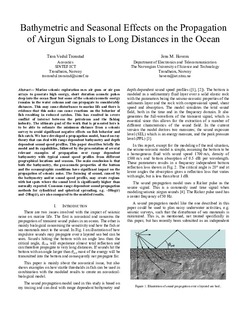| dc.contributor.author | Tronstad, Tron | |
| dc.contributor.author | Hovem, Jens Martin | |
| dc.date.accessioned | 2018-01-05T16:38:13Z | |
| dc.date.available | 2018-01-05T16:38:13Z | |
| dc.date.created | 2012-03-12T11:16:14Z | |
| dc.date.issued | 2011 | |
| dc.identifier.citation | OCEANS 2011 MTS/IEEE KONA | nb_NO |
| dc.identifier.isbn | 978-1-4577-1427-6 | |
| dc.identifier.uri | http://hdl.handle.net/11250/2476087 | |
| dc.description.abstract | Marine seismic exploration uses air guns or air gun arrays to generate high energy, short duration acoustic pulses deep into the ocean floor but some of the seismic/acoustic energy remains in the water column and can propagate to considerably distances. This may cause disturbance to marine life and there is evidence that this noise can cause reactions on the behavior of fish resulting in reduced catches. This has resulted in severe conflict of interest between the petroleum and the fishing industry. The ultimate goal of the work that is presented here is to be able to estimate the minimum distance from a seismic survey to avoid significant negative effects on fish behavior and fish catch. We have developed a propagation model, based on ray theory that can deal with range dependent bathymetry and depth dependent sound speed profiles. This paper describes briefly the model and its capabilities, followed by the presentation of several relevant examples of propagation over range dependent bathymetry with typical sound speed profiles from different geographical locations and seasons. The main conclusion is that both the bathymetry, the geo-acoustic properties of the bottom and the oceanographic conditions have significant impact on the propagation of seismic noise. The focusing of sound, caused by the bathymetry and/or sound speed profile, may create regions with hot spots where the sound level is significantly higher than normally expected. Common range dependent sound propagation methods for cylindrical and spherical spreading, e.g. -10log(r) and -20log(r), are also compared to the modeled results. | nb_NO |
| dc.language.iso | eng | nb_NO |
| dc.publisher | IEEE | nb_NO |
| dc.relation.ispartof | OCEANS'11 MTS/IEEE KONA : Proceedings of a meeting held 19-22 September 2011, Waikoloa, Hawaii, USA | |
| dc.title | Bathymetric and seasonal effects on the propagation of airgun signals to long distances in the Ocean | nb_NO |
| dc.type | Chapter | nb_NO |
| dc.description.version | acceptedVersion | |
| dc.identifier.doi | 10.23919/OCEANS.2011.6107248 | |
| dc.identifier.cristin | 914615 | |
| dc.description.localcode | ©2011 MTS. This is the authors' accepted version of the manuscript. Personal use of this material is permitted. Permission from IEEE must be obtained for all other uses, in any current or future media, including reprinting/republishing this material for advertising or promotional purposes, creating new collective works, for resale or redistribution to servers or lists, or reuse of any copyrighted component of this work in other works. | nb_NO |
| cristin.unitcode | 194,63,35,0 | |
| cristin.unitname | Institutt for elektronikk og telekommunikasjon | |
| cristin.ispublished | true | |
| cristin.fulltext | postprint | |
| cristin.qualitycode | 1 | |
